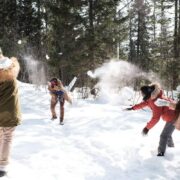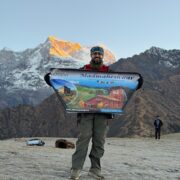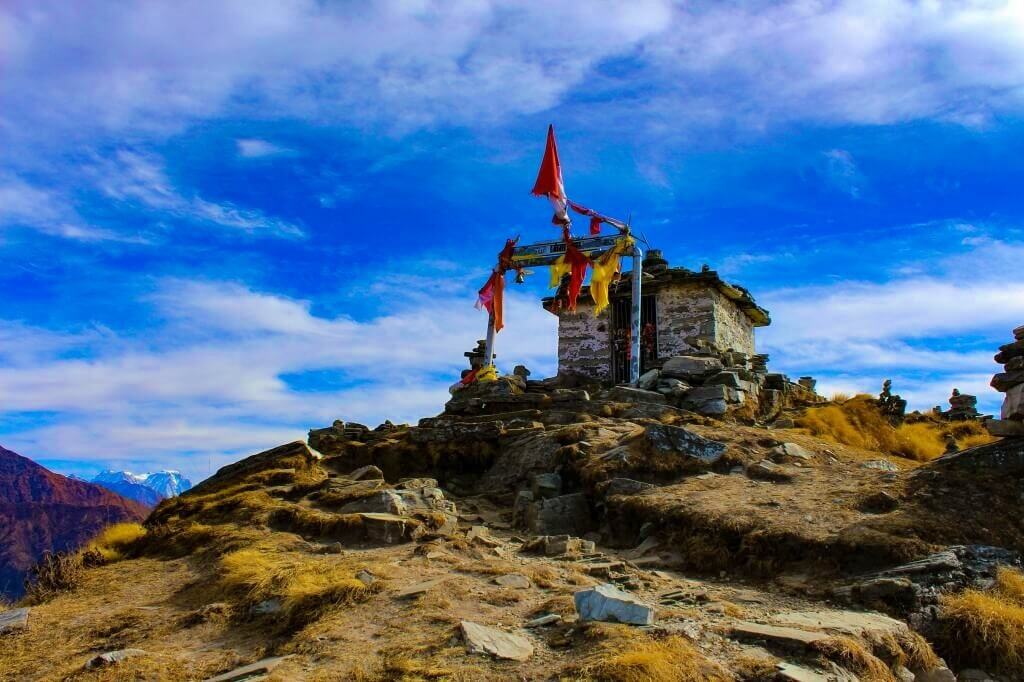
Chopta from June to September: A Misty Retreat into the Monsoon Hills
The Monsoon Magic of Chopta: First Impressions from the Hills
Chopta Chandrashila Trek From Delhi : When we reached Chopta in early July, the road was still glistening from the morning rain, and the mountain breeze smelled like pine and fresh earth. The moment we stepped out of the car, we were surrounded by clouds that had dropped low to kiss the meadows. The whole valley felt like it had taken a deep, refreshing breath.
What struck me first was the silence no honking, no chaos. Just the sound of water droplets falling from deodar leaves and distant birdsong echoing through the mist. I had booked my chopta tour package through TourMyHoliday, and honestly, everything from the driver to the accommodation was well-managed. It allowed us to just be present—to take in the wild greens and soft greys of this monsoon paradise.
During this season, Chopta transforms into something you won’t see any other time of the year. The alpine meadows turn a deep, velvet green. Tiny wildflowers bloom along the trails white, purple, and yellow and butterflies seem to dance with the fog. The best part? You don’t have to climb high to witness beauty it’s everywhere, even from your cottage balcony.
The monsoon also brings waterfalls to life. On the way to Chopta from Ukhimath, we stopped at a couple of spontaneous waterfalls that only exist during this season. The water was crystal clear and freezing cold, but dipping our hands in it felt purifying.
Another surprise was the cloud play. One minute, you’re staring at a distant peak. The next, it’s gone, swallowed by mist. That dance between the clouds and the mountains never gets old. We spent hours just sitting on rocks, sipping chai, wrapped in shawls, watching the weather write poetry in the sky.
If you’ve ever thought of visiting Chopta, monsoon might not be your first choice. But for those who crave peace, raw beauty, and a softer side of the Himalayas, this is when the mountains open their heart. And trust me, they do it quietly.
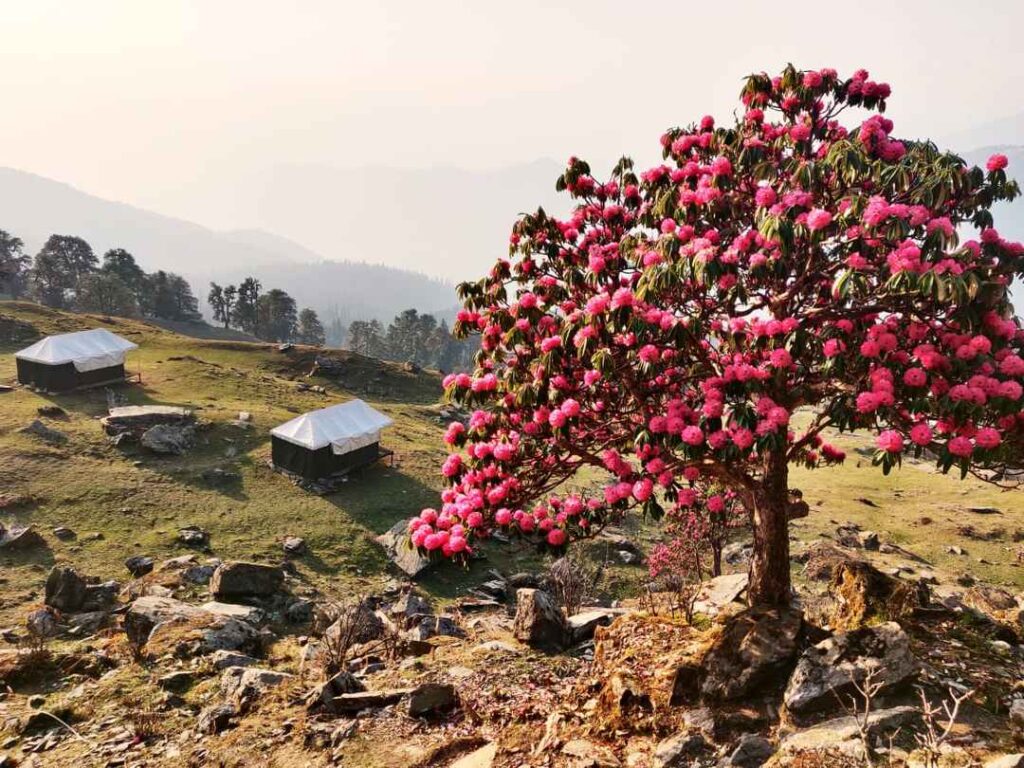
Itinerary For Chopta
DAY 0: Delhi to Rishikesh to Sari Village
- Journey Start Time: Depart from Botanical Garden Metro Station at 10:00 PM.
- Begin your overnight journey towards Sari Village via Rishikesh.
- Stop at Devprayag: Witness the confluence of the Bhagirathi and Alaknanda rivers during the journey.
DAY 1: Sari Village to Deoriatal
- Arrival at Sari Village: Check in to your homestay and freshen up.
- Trek to Deoriatal: Start your trek (2 . 5 km, approx. 1.5-2 hours).
- Enjoy Deoriatal: Relax and take in the serene views of the lake.
- Return to Sari Village: Returning to your starting point and enjoy the evening.
DAY 2: Sari Village to Tungnath & Chandrashila
- Breakfast: Enjoy a hearty breakfast at your homestay.
- Drive to Chopta: About 1 hour from Sari Village.
- Trek to Tungnath Temple: 3.5 km trek.
- Summit Chandrashila: An additional 1.5 km from Tungnath.
- Return to Chopta/Sari: After completing your treks, head back for an overnight stay at Chopta camps.
DAY 3: Chopta to Delhi
- Breakfast: Have an early breakfast at your camp in Chopta.
- Early Morning Departure: Leave Chopta early in the morning.
- Visit Dhari Devi Temple: Stop on your way back.
- Return to Delhi: A long drive of approximately 10-12 hours.
Is Chopta Safe During Monsoon? Travel Tips for June to September
Before we left for Chopta in July, one of the most common questions friends asked was, “Is it even safe to go during monsoon?” And it’s valid. Mountain weather can be unpredictable. But after completing the trip, I can say this: if you prepare well and go through reliable chopta tour packages, it’s not just safe—it’s serene.
We booked our chopta tour package from Delhi through TourMyHoliday. Their team made sure our journey was scheduled to avoid landslide-prone routes and kept us updated with real-time weather checks. The roads were drivable, the driver experienced, and we didn’t face any major blockages—just slow, careful driving and stunning views.
Yes, the rains make trails slippery, so you do have to be cautious. But with good trekking shoes, a poncho, and waterproof backpacking gear, it’s not only doable, it’s actually more magical. The greenery is richer, and the air feels cleaner. Plus, the crowd is minimal, which means you get to explore in peace.
Here are a few safety tips we followed:
- Always start your treks early — clouds tend to build up post-noon.
- Stick to marked trails — fog can reduce visibility, and you don’t want to wander off-track.
- Keep extra buffer time — weather can cause small delays.
- Travel with a guide or in a group — especially if it’s your first time.
Booking with a complete chopta tour package helped us avoid the planning stress. They handled permits, stays, transport, and even had backup plans in case weather interrupted our schedule.
So, is it safe? Absolutely with the right support, it’s a peaceful, lush experience you’ll never forget.
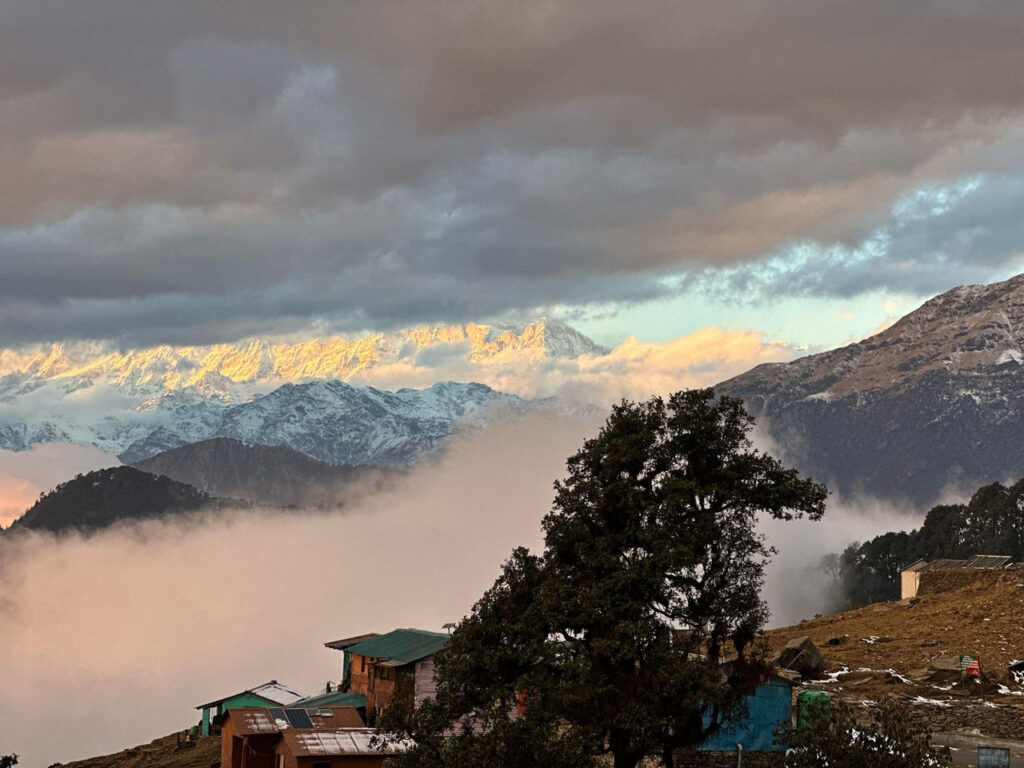
Chopta Tungnath Trek: A Rain-Drenched Trail to Spiritual Heights
The morning we decided to hike the Chopta Tungnath trek, it had rained all night. The forest trail was wet, the leaves heavy with droplets, and the air smelled of pine and wet soil. We weren’t sure if we’d make it all the way up, but something about the misty path called us forward.
This trail, part of the legendary Panch Kedar pilgrimage, leads to the Tungnath Temple, the highest Shiva temple in the world. Doing the tungnath temple trek during the monsoon felt like walking through a living poemevery step surrounded by whispering trees, chirping birds, and soft drizzles falling on your raincoat.
What makes the chopta tungnath trek extra special in monsoon isn’t just the spiritual vibe—it’s the solitude. With fewer people on the trail, we walked mostly alone, just the sound of our boots in the mud and the occasional bhajan humming from someone far ahead. Small streams formed along the path, and at one point, we stopped near a waterfall that hadn’t been there a day ago. That’s the magic of this season.
Midway through, the clouds rolled in and wrapped the mountains in white. For a moment, we couldn’t see anything beyond five feet but then the fog shifted, and in the distance, we saw the silhouette of the temple. It felt divine.
Tungnath is not a flashy shrine it’s humble, ancient, and radiates peace. Rain dripped from the temple roof as we offered prayers, soaked but smiling. We sat for a while, watching the clouds dance over the valley. There was a stillness in the air, like the mountain wanted us to slow down and listen.
Descending was slippery but beautiful. Flowers were in bloom along the edges, and we met a few locals who offered us warm chai in a small shack. I remember thinking, “Why doesn’t everyone come here in the monsoon?” The answer is probably comfort. But if you’re willing to get a little wet, this trail will gift you moments that stay long after you’ve left.
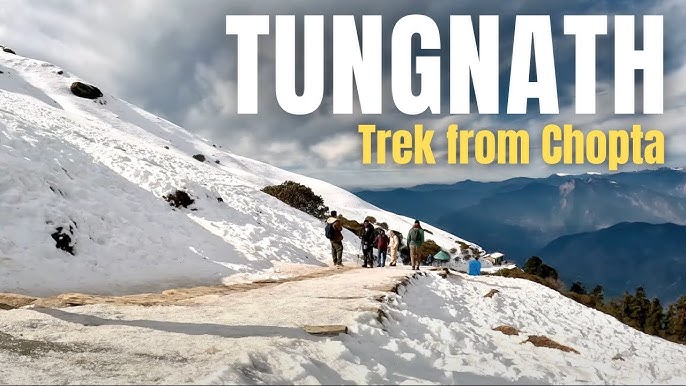
Chopta Chandrashila Trek: The Summit That Touched My Soul
The day we attempted the Chopta Chandrashila trek was one of those misty monsoon mornings where everything feels half-dream, half-reality. The clouds hung low, the grass was drenched in dew, and our jackets were zipped up tight against the cold breeze. Despite the drizzle, we were determined. After all, the chandrashila summit trek was something we had been looking forward to for months.
The trail begins from Tungnath and leads you higher into the clouds, quite literally. The path was a mix of stone and mud, slippery at times but absolutely enchanting. I remember looking up and seeing a halo of mist around a group of tall rhododendron trees it looked like a painting.
This part of the chandrashila trek isn’t just physically demanding, it’s emotionally rich. Every few meters, the fog would clear for a moment and reveal a distant snow-capped peak, only to disappear again. It was like nature was playing hide-and-seek with us.
We took it slow. The altitude made breathing a little heavier, but the cold air was refreshing. Midway, our guide from TourMyHoliday pointed to a group of mountain goats far off on a ridge—something we might’ve missed if we had rushed. He told us that monsoon brings the mountains to life, and he was right. Wildflowers, tiny brooks, birdsong, and that earthy scent—Chopta feels like another world in this season.
Finally, we reached Chandrashila. Though the panoramic views were partially hidden behind swirling clouds, there was one breathtaking moment. The sky briefly opened, and we caught a glimpse of Nanda Devi and Chaukhamba peaks gleaming in the distance. Everyone went silent. We just stood there cold, wet, but completely content.
The chopta chandrashila trek during monsoon is more than just a hike; it’s a journey into yourself. It teaches patience, resilience, and wonder. And even if the skies don’t always stay clear, the moments you do get feel hard-earned and incredibly rewarding.
We descended slowly, rain starting again, hearts full. That summit changed something in me. Maybe it was the climb, maybe the silence, or maybe just being high enough to touch the clouds.
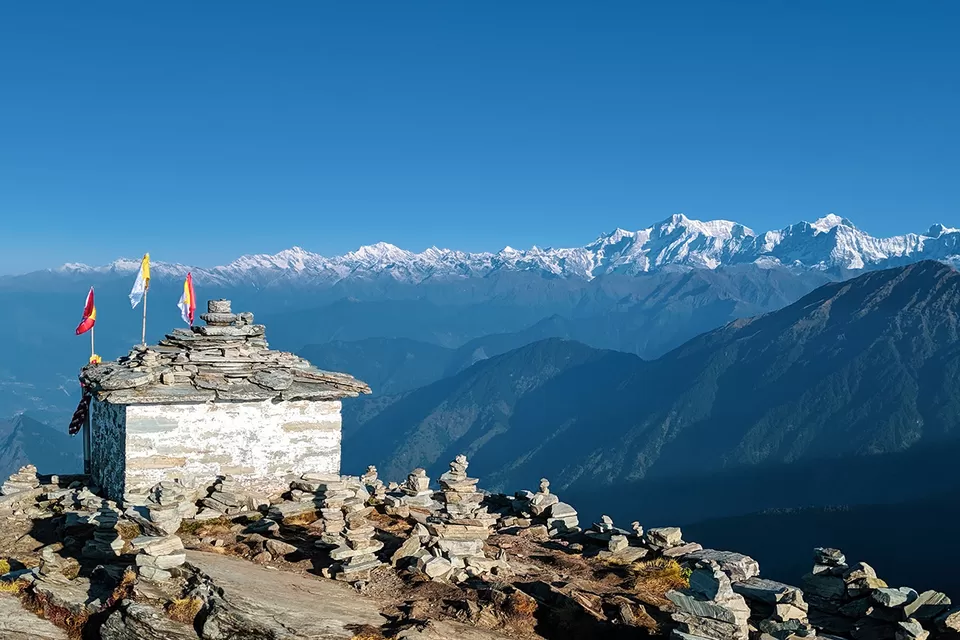
Chopta in Monsoon: What You See Only Between June to September
Monsoon in the Himalayas is not for everyone—but if you ask me, it’s the most beautiful time to see Chopta. Between June and September, the region transforms. It’s as if someone polished the trees, cleaned the sky with rain, and switched on a filter called “lush.” This is the time when Chopta breathes deepest.
We had booked our chopta tour package specifically for this season. A friend told me, “Go now, or you’ll never see those monsoon clouds rolling over the meadows.” And she was right.
The first thing that hit me was the green an overwhelming, endless green. Bugyals (alpine meadows) near Chopta were so vibrant they looked fake. The deodar and oak forests glistened with dew, and small seasonal waterfalls poured from cliffs that were dry in winter.
Wildflowers were blooming everywhere bright pinks, purples, and yellows dotting the path to Tungnath. These flowers only bloom during the rainy season, and they gave the landscape a magical softness, like walking through a dream.
The mist played tricks with our eyes. One moment we could see distant peaks, the next moment everything vanished behind a white curtain. But that added to the beauty. There’s something romantic about not knowing what you’ll see next. And trust me, when the clouds move and reveal a mountain top, it’s a gasp-worthy moment.
If you’ve ever thought of booking chopta tour packages, this season might just surprise you. Yes, there’s rain. Yes, it’s slippery. But the reward? You get Chopta at its purest no crowds, no rush, just nature at its dramatic best.
We spent our evenings sipping chai outside our cottage, wrapped in shawls, watching lightning flash silently over the mountains. That peaceful feeling? You only get it in monsoon.
Want to know more about Chopta before you plan your trip? Visit this page for complete details.”
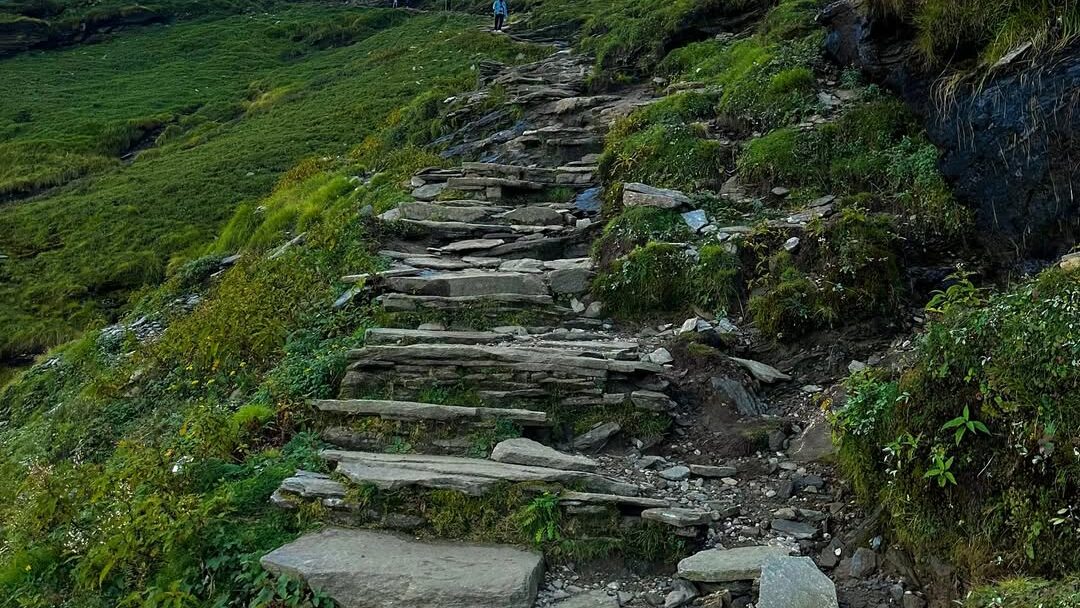
Chopta Tour Package from Delhi: Our Rainy Road Trip Experience
We began our trip before sunrise from Delhi, with clouds already looming over the city skyline. The weather app said “scattered showers,” but we took it as a blessing it was exactly what we wanted for our monsoon escape. We’d booked a chopta tour package from Delhi through TourMyHoliday, and the itinerary was all set: a comfortable ride, scenic halts, and just enough flexibility to enjoy the journey, not just the destination.
As we left the dusty plains behind, the drive started getting magical. The highway near Haridwar was soaked in fresh rain, and by the time we hit Devprayag, the rivers were roaring crystal and chocolate merging into thunderous beauty. I remember the windows fogging up from the cold outside, and all of us wiping them clean just to glimpse the green valleys beyond.
What really made the ride memorable was the stop at Srinagar (Uttarakhand, not Kashmir!). Hot maggi, pakoras, and ginger chai from a small stall felt like a gourmet meal with that foggy mountain view. Our driver, local and experienced, shared stories of pilgrims and trekkers who often visit for the chopta tungnath trek from delhi and beyond. His insights gave the ride a personal layer we didn’t expect.
As we climbed closer to Chopta, the road narrowed and the trees thickened. It felt like we were driving into a forest from a fairy tale. Clouds rolled over the hills, sometimes hiding the road altogether. But it wasn’t scary—it was thrilling. The kind of thrill that makes your heart race and your camera lens fog up.
We reached Chopta just as the sun was setting behind thick clouds. The air was crisp, cool, and quiet. The cottages provided by our tour package were nestled in a clearing, surrounded by tall trees. I remember stepping out of the car, taking a deep breath, and thinking this is exactly what I needed.
That’s the beauty of booking a chopta tour package from delhi you don’t have to plan every detail. Just sit back, enjoy the ride, and let the mountains take over.
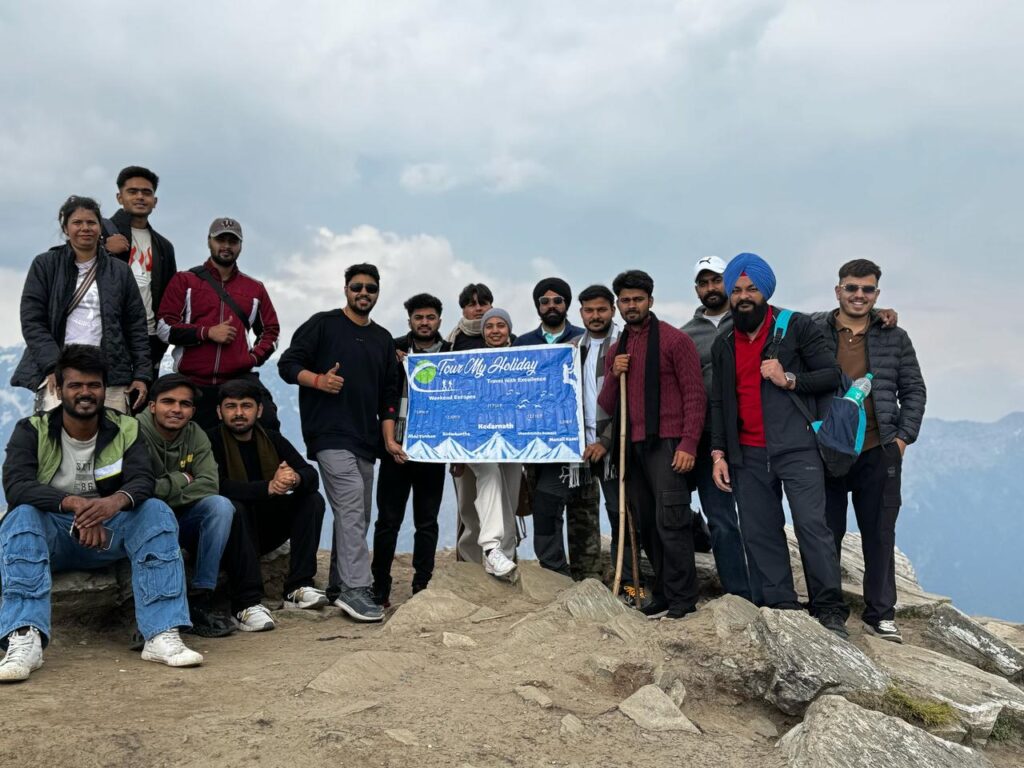
Is Chopta Safe in Monsoon? Here’s What We Learned
Before we left for our trip, almost everyone asked the same question: “Is Chopta safe during the rainy season?” Even we had a few doubts. Landslides, slippery trails, and unpredictable weather were on our minds. But now, having done the chopta tungnath trek in the middle of the monsoon, I can tell you: yes, it’s safe if you’re a little mindful.
We traveled with TourMyHoliday, and their planning gave us peace of mind. Our guide was local, familiar with every twist of the road and every stone on the trail. On our tungnath temple trek, he pointed out places where the stones were loose or where moss made it slippery, always guiding us slowly and patiently.
Monsoon does make the trail more challenging, no doubt. The stone steps to Tungnath can get wet and mossy. But if you have good grip shoes and take your time, it’s actually quite doable. In fact, I think the rain made it more beautiful. The forest was alive with sound the crunch of leaves, the chirping of hidden birds, and the occasional rustle from somewhere deep in the trees.
We also learned that most landslide-prone zones on the way to Chopta are well monitored, and drivers usually avoid travel during heavy downpours. Our journey was smooth, with plenty of rest stops and updated weather tracking. We didn’t feel unsafe, even for a moment.
The chandrashila trek can be a bit more foggy at the top, but that adds to the magic. Our guide checked the visibility conditions before we attempted the summit, and though we didn’t get full 360° views, the experience of walking in the mist was unforgettable.
In short yes, Chopta is safe during monsoon, especially if you plan through a reliable tour operator and stay updated with the weather. Be cautious, wear proper gear, and go with the rhythm of the mountains.
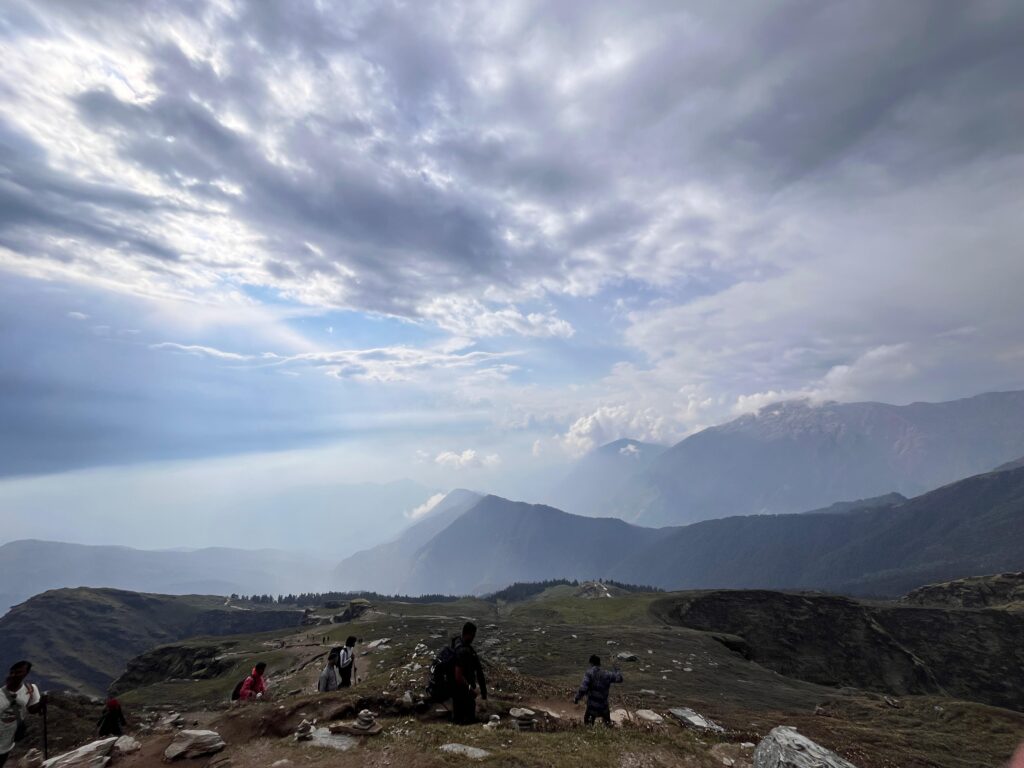
Local Life in the Rain: Experiencing Chopta Beyond Trekking
Most people think of Chopta only in terms of trekking—Tungnath, Chandrashila, and back. But for us, the real soul of Chopta revealed itself when we slowed down and just observed the local life, especially during the monsoon.
Thanks to our chopta tour packages, we weren’t rushed with back-to-back activities. On one of the drizzly afternoons, we skipped the tungnath temple trek and simply walked around the small settlement where our cottage was located. The local villagers were welcoming, and life here moved at a beautifully slow pace.
We saw shepherds guiding their cattle through wet grasslands, children jumping in puddles with carefree laughter, and women carrying firewood on their backs, wrapped in bright wool shawls. A chai stall owner offered us warm tea with stories—how the weather shapes their daily life and how, in monsoon, the forest around Chopta feels almost sacred.
One unforgettable experience was sitting by a window during heavy rain and watching clouds roll in over the meadows. In that silence, you begin to understand why the locals are so deeply connected to this land.
Our guide also took us to a lesser-known meadow one morning, as part of the chopta chandrashila trek route. It wasn’t in our plan, but it turned out to be one of the most peaceful places I’ve ever seen. No tourists, just mist, tall grass swaying with the breeze, and wildflowers wet from the rain. These are the parts of Chopta that aren’t in travel brochures—but they stay with you long after the trip ends.
Monsoon gives you the chance to see a slower, quieter side of the mountains. It’s not just about trekking to peaks—it’s about walking down paths where locals live, where nature breathes deeply, and where you realize that sometimes, doing nothing is the best way to truly travel.
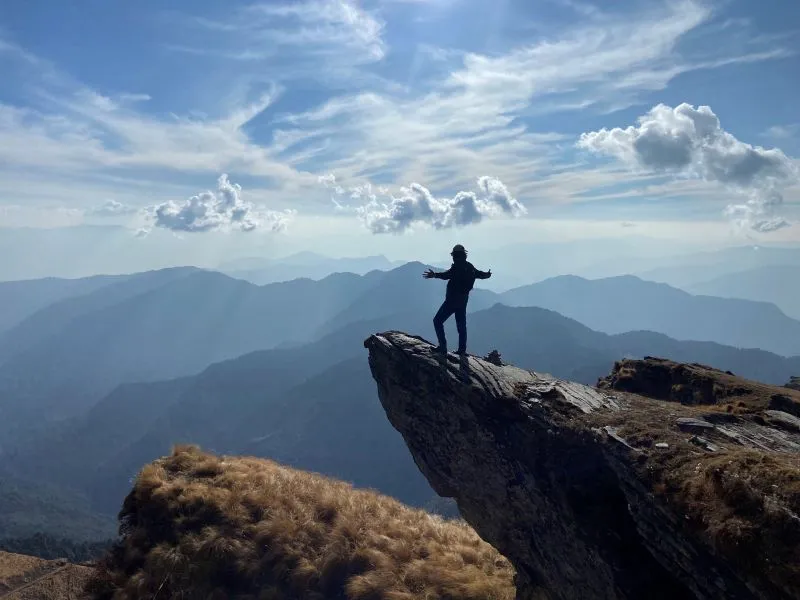
Chandrashila Summit Trek in Rain: A Dreamlike Climb Above the Clouds
The day we did the chandrashila summit trek, it had rained early in the morning. The path was misty, the stones were wet, and everything felt like a scene from a dream. We had booked our chopta chandrashila trek from Delhi with TourMyHoliday, and our guide gave us the green signal to go ahead, saying, “Today the clouds will walk with you.”
That’s exactly how it felt.
The trek from Tungnath to Chandrashila is short, steep, and in the monsoon magical. As we climbed, clouds kept sweeping past us, sometimes hiding everything around, and then suddenly revealing a cliff or a valley out of nowhere. We were surrounded by silence, except for the wind and the occasional sound of distant thunder.
There’s something about the chandrashila trek in this season that stirs your soul. Wildflowers bloom along the way, untouched by footsteps, and the stones glisten with rain. We didn’t race to the top. We walked slow, paused often, and let the moment sink in.
At the summit, visibility was low but instead of feeling disappointed, we felt incredibly lucky. Imagine standing above the clouds, wrapped in mist, with cold air brushing your face, and a sense of being in another realm. It wasn’t the postcard view we expected it was something better. Something we could feel.
My brother, usually the loud one in the group, sat quietly at the edge, sipping water, just staring into the fog. That silence said more than words.
Coming down, the rain began again. Light, steady, and poetic. We walked back hand-in-hand, soaked but smiling. The chandrashila summit trek had shown us that beauty isn’t always in what you see sometimes it’s in what you feel.
If you’re planning the chopta chandrashila trek from delhi during the monsoon, don’t chase perfect weather. Embrace the unexpected. The clouds might block the views, but they’ll open something even deeper within you.

Why Monsoon is the Best Time for Chopta Tour Packages
Most travelers avoid the hills during the rainy season. But for us, choosing a chopta tour package in monsoon turned out to be the best decision of the year. It’s not just about fewer tourists or the lower prices it’s about the kind of experience that’s impossible to find in any other season.
The tungnath temple trek in the rain, for instance, wasn’t just scenic it was spiritual. We didn’t climb for a photo or a checklist. We climbed through clouds, in silence, and reached a 1000-year-old temple where the only sound was rain falling softly on stone. That kind of moment stays with you.
Monsoon transforms Chopta. Meadows burst into deep green, the forests smell like rain and pine, and the sky plays hide-and-seek with the sun. Every turn of the road or trail brings something new sometimes a hidden waterfall, other times a herd of sheep calmly grazing in the mist.
One thing we loved about our chopta tour packages with TourMyHoliday was the flexibility they offered. On days when the weather didn’t allow trekking, they arranged cozy stays, scenic drives, and even indoor games to keep us engaged. The package felt less like a “trip” and more like a retreat.
The monsoon also gave us more time to connect with the locals. Without the rush of crowds, they opened up more—offering us homemade food, sharing stories, and teaching us about the region’s flora and traditions. It made us feel like we were visiting old friends rather than just tourists passing through.
And yes, the discounts helped too. The chopta tour package we got was more affordable than peak season rates, and we had the place almost to ourselves. No waiting in queues, no traffic jams, no noise just rain, mountains, and peace.
So if you’re wondering when to plan your next Chopta trip, don’t overlook the rains. The monsoon doesn’t hide Chopta’s beauty it reveals its soul.

Top 20 FAQs for Chopta Monsoon Travel (June to September)
- Is Chopta safe to visit during the monsoon?
Yes, Chopta is generally safe during the monsoon months (June to September), but it’s important to stay updated with weather forecasts and travel with a guide or tour agency like TourMyHoliday for added safety. - What is the weather like in Chopta from June to September?
Expect cool, misty days with frequent rain. The temperature ranges from 10°C to 20°C, and the lush greenery makes it very scenic. - Can I do the Chopta Tungnath Trek during the rainy season?
Yes, the trek remains open, and while the trail can be slippery, it’s absolutely doable with good shoes and a local guide. - Is the Chandrashila Summit Trek worth doing in monsoon?
Definitely. While views may be foggy, the mystical vibe, clouds drifting through you, and quiet trails make it unforgettable. - Which is the best Chopta tour package for monsoon travel?
A package that includes stay, food, transport, local guides, and flexibility for weather changes works best—TourMyHoliday offered us exactly that. - Are roads from Delhi to Chopta operational during monsoon?
Yes, the roads are functional. There might be occasional delays due to landslides, so it’s good to travel during the day and with an experienced driver. - How long does the Chopta Tungnath Trek take?
The trek is around 3.5 km one way and usually takes 2–3 hours, depending on pace and weather. - What should I pack for Chopta in monsoon?
Raincoat, waterproof trekking shoes, warm layers, a flashlight, dry snacks, and a small medical kit. - Are there leeches on the trek during rains?
Leeches can appear in grassy and damp areas. Wearing long socks and keeping salt handy helps. - Is it crowded in Chopta during June to September?
Not really. This is considered an off-season, so the region is quieter and perfect for peaceful getaways. - Can I visit Tungnath Temple in monsoon?
Yes, the temple is open. It feels even more spiritual in the mist and rain, with fewer visitors around. - How far is Chopta from Delhi?
Roughly 450 km by road. It takes about 12–14 hours depending on the route and weather conditions. - Is monsoon a good time for photography in Chopta?
Absolutely. The mist, dramatic skies, waterfalls, and vibrant greenery offer incredible photo opportunities. - Is Chopta suitable for solo travelers in the rainy season?
Yes, especially if you enjoy solitude and nature. Just stay connected and opt for a local guide. - Are budget-friendly Chopta tour packages available in monsoon?
Yes, this is actually the best time to find budget Chopta tour packages with great discounts. - Which treks are best in Chopta during monsoon?
The Tungnath Temple Trek, Chandrashila Summit Trek, and short trails through the meadows are all enjoyable. - How is mobile network connectivity in Chopta?
Limited. Jio and BSNL may work in patches. Be prepared for poor or no data in most areas. - What is the highlight of visiting Chopta in the rainy season?
The serenity, lush alpine meadows, and mystical views where clouds float at your eye level. - Can families visit Chopta during monsoon?
Yes, especially nature-loving families. Just take basic precautions and avoid slippery hikes with small kids. - What places can I visit near Chopta during this season?
Tungnath Temple, Chandrashila Peak, Deoria Tal, and nearby forest trails are all beautiful and accessible.
Recent Posts
Chakrata in Winters
Madmaheshwar Trek Difficulty & Beginner’s Complete Guide
Chopta in Winters
Tags

Thailand


